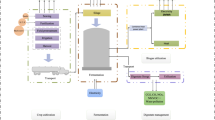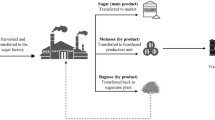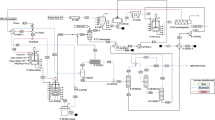Abstract
Purpose
Though the development of biofuel has attracted numerous studies for quantifying potential water demand applying life cycle thinking, the impacts of biofuel water consumption still remain unknown. In this study, we aimed to quantify ecological impact associated with corn-based bioethanol water consumption in Minnesota in responding to different refinery expansion scenarios by applying a life cycle impact assessment method.
Methods
This ecological damage assessment method for quantifying water consumption impacts was proposed by Pfister et al. in 2009 (Environ Sci Technol 43: 4098–4104, 2009) using an impact characterization factor integrating terrestrial net primary production and precipitation. In this study, we derived the spatially explicit eco-damage characterization factors for 81 watersheds in Minnesota and compiled location-specific water consumption data for all current and planned bioethanol production facilities and feedstock production. The ecological damage caused by bioethanol production (ΔEQEtOH in m2⋅yr) was then calculated on both watershed and refinery-plant levels. Additional refinery expansion scenarios were established for testing the effectiveness in changing ΔEQEtOH.
Results and discussion
The results show that ecological impact ΔEQEtOH varied by more than a factor of 3 between watersheds. Minnesota consumed 40 billion liters of water to produce 2.3 billion liters of ethanol as of 2007 (17 L water per liter of ethanol). The geographical distribution of ΔEQEtOH was shown to be uneven with a cluster of high-impact regions around the center of the state. The planned refinery expansion is expected to increase the state’s corn ethanol production capacity by 75% and ΔEQEtOH by 65%. However, strategically locating the planned expansion in the low-impact areas is expected to minimize the increases in ΔEQEtOH down to 19% from 65%.
Conclusions
The scenario analysis shows that strategically sourcing corn from low-impact regions can result in significantly less water use impact compared to a baseline scenario. The results indicate that employing the water consumption impact assessment can provide additional insights in policy making. The environmental impacts related to the change of plant infrastructure and agricultural practices associated with the development of the renewable energy industry should be considered as well for identifying the most sustainable alternatives.


Similar content being viewed by others
References
Bayart JB, Bulle C, Deschenes L, Margni M, Pfister S, Vince F, Koehler A (2010) A framework for assessing off-stream freshwater use in LCA. Int J Life Cycle Assess 15(5):439–453
Bringezu S, Schütz H, O’Brien M, Kauppi L, Howarth R, McNeely J (2009) Towards sustainable production and use of resources: Assessing biofuels. International Panel for Sustainable Resources Management, UNEP, Paris
Chiu YW, Walseth B, Suh S (2009) Water embodied in bioethanol in the United States. Environ Sci Technol 43(8):2688–2692
de Fraiture C, Giordano M, Liao Y (2008) Biofuels and implications for agricultural water use: blue impacts of green energy. Water Policy 10(S1):67–81
Environmental Protection Agency (2008a) Federal register: Renewable Fuel Standard for 2009, issued pursuant to section 211(o) of the Clean Air Act, vol 73. USEPA, Washington, DC
Environmental Protection Agency (2008b) Federal register: revised Renewable Fuel Standard for 2008, issued pursuant to section 211(o) of the Clean Air Act as amended by the Energy Independence and Security Act of 2007, vol 73. USEPA, Washington, DC
Ewing B, Reed A, Galli A, Kitzes J, Wackernagel M (2010) Calculation methodology for the national footprint accounts: 2010 edition. Global Footprint Network, Oakland, CA
Falkenmark M, Rockström J (2004) Balancing water for humans and nature: the new approach in ecohydrology. Earthscan, London
Fargione J, Hill J, Tilman D, Polasky S, Hawthorne P (2008) Land clearing and the biofuel carbon debt. Science 10(5867):1235–1238
Frischknecht R (2005) Ecoinvent data v1.1 (2004) From heterogenous databases to unified and transparent lci data. Int J Life Cycle Assess 10(1):1–2
GAO (2009) Energy-water nexus: many uncertainties remain about national and regional effects of increased biofuel production on water resources. Report to the Chairman, Committee on Science and Technology, House of Representatives. GAO, Washington, DC
Gerbens-Leenes W, Hoekstra AY, van der Meer TH (2009) The water footprint of bioenergy. P Natl A Sci 106(25):10219–10223
Goedkoop M, Spriensma R (2000) The Eco-Indicator 99: a damage oriented method for life cycle impact assessment (methodology report). Pré Consultants, Amersfoort
Hauschild M (2006) Spatial differentiation in life cycle impact assessment: a decade of method development to increase the environmental realism of LCIA. Int J Life Cycle Assess 11:11–13
Hoekstra AY, Chapagain AK, Aldaya MM, Mekonnen MM (2011) The water footprint assessment manual: setting the global standard. Earthscan, London
Huijbregts MAJ, Schöpp W, Verkuijlen E, Heijungs R, Reijnders L (2000) Spatially explicit characterization of acidifying and eutrophying air pollution in life-cycle assessment. J Ind Ecol 4(3):75–92
Kim S, Dale BE (2005) Life cycle assessment of various cropping systems utilized for producing biofuels: bioethanol and biodiesel. Biomass Bioenerg 29(6):426–439
King CW, Webber ME (2008) Water intensity of transportation. Environ Sci Technol 42(21):7866–7872
Koehler A (2008) Water use in LCA: managing the planet’s freshwater resources. Int J Life Cycle Assess 13(6):451–455
Milà i Canals L, Chenoweth J, Chapagain A, Orr S, Antón A, Clift R (2009) Assessing freshwater use impacts in LCA: part I—inventory modelling and characterisation factors for the main impact pathways. Int J Life Cycle Assess 14(1):28–42
Minnesota Climatology Working Group (2010) Interactively retrieve climate data. Minnesota Climatology Working Group, MN DNR. http://climate.umn.edu/. Accessed 15 Jan 2009
Minnesota Department of Agriculture (2010) Minnesota ethanol industry. MNDA. http://www.mda.state.mn.us/news/publications/renewable/ethanol/plantsreport.pdf. Accessed 16 May 2010
Minnesota Pollution Control Agency (2007) Planning and constructing an ethanol plant in Minnesota: a guidance document. Minnesota Pollution Control Agency, St. Paul, MN
Mishra GS, Yeh S (2011) Life cycle water consumption and withdrawal requirements of ethanol from corn grain and residues. Environ Sci Technol 45(10):4563–4569
Minnesota Department of Natural Resources (2008a) Minnesota’s watershed basins. MN DNR. http://www.dnr.state.mn.us/watersheds/map.html. Accessed 11 Feb 2010
Minnesota Department of Natural Resources (2008b) Water appropriations permit program. Minnesota Department of Natural Resources. http://www.dnr.state.mn.us/waters/watermgmt_section/appropriations/wateruse.html. Accessed 01 Sept 2009
Mohamed Y, Van Den Hurk B, Savenije H, Bastiaanssen W (2005) Hydroclimatology of the Nile: results from a regional climate model. Hydrol Earth Syst Sc 2(1):319–7364
Mubako S, Lant C (2008) Water resource requirements of corn-based ethanol. Water Resour Res 44:W00A02
National Research Council (2008) Water implications of biofuels production in the United States. National Academies Press, Washington, DC
Nebraska Energy Office (2011) Energy statistic. Nebraska Energy Office. http://www.neo.ne.gov/. Accessed 10 Jan 2011
Nemani RR, Keeling CD, Hashimoto H, Jolly WM, Piper SC, Tucker CJ, Myneni RB, Running SW (2003) Climate-driven increases in global terrestrial net primary production from 1982 to 1999. Science 300(5625):1560–1563
Patzek TW (2006) A statistical analysis of the theoretical yield of ethanol from corn starch. Nat Resour Res 15(3):205–212
Pennington DW, Margni M, Ammann C, Jolliet O (2005) Multimedia fate and human intake modeling: spatial versus nonspatial insights for chemical emissions in western Europe. Environ Sci Technol 39(4):1119–1128
Pfister S, Koehler A, Hellweg S (2009) Assessing the environmental impacts of freshwater consumption in LCA. Environ Sci Technol 43(11):4098–4104
Pfister S, Bayer P, Koehler A, Hellweg S (2011) Environmental impacts of water use in global crop production: hotspots and trade-offs with land use. Environ Sci Technol 45(13):5761–5768
Pimentel D (2003) Ethanol fuels: energy balance, economics, and environmental impacts are negative. Nat Resour Res 12(2):127–134
Pimentel D, Patzek TW (2005) Ethanol production using corn, switchgrass, and wood; biodiesel production using soybean and sunflower. Nat Resour Res 14(1):65–76
Potting J, Schöpp W, Blok K, Hauschild M (1998) Site-dependent life-cycle impact assessment of acidification. J Ind Ecol 2(2):63–87
Potting J, Hertel O, Schöpp W, Bastrup-Birk A (2006) Spatial differentiation in the characterisation of photochemical ozone formation: the EDIP2003 methodology. Int J Life Cycle Assess 11:72–80
Renewable Fuels Association (2008) Ethanol biorefinery statistics. Renewable Fuels Association. http://www.ethanolrfa.org/pages/statistics. Accessed 10 Jan 2010
Ridoutt BG, Pfister S (2010) A revised approach to water footprinting to make transparent the impacts of consumption and production on global freshwater scarcity. Global Environ Chang 20(1):113–120
Romanow S (2007) Biofuels production in U.S. impacts water resources. Hydrocarb Process 86(12):23–725
Scown CD, Horvath A, McKone TE (2011) Water footprint of U.S. transportation fuels. Environ Sci Technol 45(7):2541–2553
Shapouri H, Duffield JA, Wang M (2003) The energy balance of corn ethanol revisited. T ASABE 46(4):959–968
Solley W, Pierce R, Perlman H (1998) Estimated use of water in the United States in 1995. US Geological Survey, Denver, CO
U.S. Department of Agriculture. (2004) 2003 farm and ranch irrigation (2002) Census of Agriculture. USDA, Washington, DC
U.S. Department of Agriculture (2010) National agricultural statistics service. USDA. http://www.nass.usda.gov/. Accessed 20 Apr 2010
Varghese S (2007) Biofuels and global water challenges. Institute for Agriculture and Trade Policy, Minneapolis
Wu M, Mintz M, Wang M, Arora S (2009) Consumptive water use in the production of ethanol and petroleum gasoline. Center for Transportation Research Energy Systems Division, Argonne National Laboratory, Lemont, IL
Acknowledgments
We thank Mr. Brian Walseth of the Industrial Ecology Lab, University of Minnesota for his assistance in corn field and irrigation data acquisition. We thank Mr. Eric Fournier for his helpful comments. This research was supported in part by USDA/CSREES and US DOE under grant number 68-3A75-7-614 and by the Legislative Citizen’s Commission on Minnesota Resources.
Author information
Authors and Affiliations
Corresponding author
Electronic supplementary material
Below is the link to the electronic supplementary material.
ESM 1
(DOC 568 kb)
Rights and permissions
About this article
Cite this article
Chiu, YW., Suh, S., Pfister, S. et al. Measuring ecological impact of water consumption by bioethanol using life cycle impact assessment. Int J Life Cycle Assess 17, 16–24 (2012). https://doi.org/10.1007/s11367-011-0328-0
Received:
Accepted:
Published:
Issue Date:
DOI: https://doi.org/10.1007/s11367-011-0328-0




